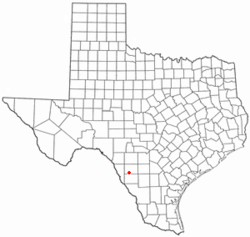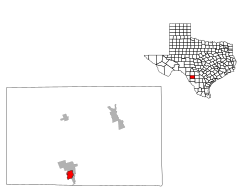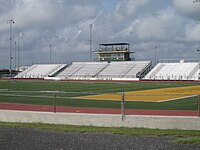Crystal City, Texas
Crystal City, Texas | |
|---|---|
 Sacred Heart Catholic Church in downtown Crystal City | |
 Location of Crystal City, Texas | |
 | |
| Country | United States |
| State | Texas |
| County | Zavala |
| Area | |
| • Total | 3.6 sq mi (9.4 km2) |
| • Land | 3.6 sq mi (9.4 km2) |
| • Water | 0.0 sq mi (0.0 km2) |
| Elevation | 558 ft (170 m) |
| Population (2000) | |
| • Total | 7,190 |
| • Density | 1,974.1/sq mi (762.2/km2) |
| Time zone | UTC-6 (Central (CST)) |
| • Summer (DST) | UTC-5 (CDT) |
| ZIP code | 78839 |
| Area code | 830 |
| FIPS code | 48-18020Template:GR |
| GNIS feature ID | 1355449Template:GR |



Crystal City is a city in and the county seat of Zavala County, Texas, United States.Template:GR The population was 7,190 at the 2000 census. The mascot of Crystal City High School is the Javelina.
History
Farming and ranching
Crystal City was originally settled by American farmers and ranchers producing cattle and various crops. The successful production of spinach crops evolved into a dominant industry. By March 26, 1937, spinach growers had erected a statue of the cartoon character Popeye in the town because his reliance on spinach for strength led to greater popularity for the vegetable, which had become a staple cash crop of the local economy. See the Popeye statue web entry.
Internment camp
During World War II, Crystal City was home to the largest of the World War II internment camps, having housed American civilians of German, Japanese, and Italian ancestry. However, the majority of internees were South American citizens.
The camp was administered by the INS and Department of Justice.[1] To reduce hardships during internment and to reunite families, the INS originally intended to detain only Japanese at Crystal City, especially the many Latin-American Japanese families brought to the United States for internment pending repatriation. Germans and Italians, however, were also held in Crystal City. In the fall of 1942, the INS assumed ownership of the Farm Security Administration's migratory farm workers' camp outside Crystal City.
Existing facilities were forty-one three-room cottages, 118 one-room structures, and some service buildings. Eventually, the INS spent more than a million dollars to construct more than 500 buildings on the camp's 290 acres (1.2 km2). Warehouses, auditoriums, administration offices, schools, clothing and food stores, a hospital, and many housing units were built. Like the camps at Kenedy and Seagoville, the Crystal City internment camp provided jobs and revenue for the town. The first German internees arrived in December 1942. The first Japanese arrived from Seagoville on March 10, 1943. In addition, prisoners were taken to Crystal City from other INS internment camps in Hawaii and Alaska (not states at the time), the United States, Puerto Rico, the West Indies, and South and Central American countries.
The population of the Crystal City camp peaked at 3,326 in May 1945. Languages spoken at Crystal City included Japanese, German, Italian, Spanish, and English. The ages of internees ranged from newborn to elderly. The variety of prisoners added to the complexities of camp organization and administration. Camp officials tried to arrange housing so that similar races and nationalities would be together. Unfortunately, strong differences emerged between those who wanted repatriation, and those who wanted to stay in the United States or return to the country they were expelled from.
The camp was divided into separate sections for Germans and Japanese. Though no physical boundaries separated the two groups, they did not interact often. They had separate auditoriums, community centers, schools, and stores. Housing units consisted of triplexes and duplexes that shared toilet and bath facilities, three-room cottages with indoor toilet and bath, and plywood huts with central latrines and baths. Except for the huts, all the available housing had cold running water, kitchen sinks, and oil stoves.
Administrators assigned housing and set food allowances based on the age and size of families. Token money was issued accordingly, and families purchased food at a large grocery store. Two separate large canteens were constructed. One was called the German General Store, and the other the Japanese Union Store. These stores accepted tokens like the central grocery. The majority of store positions were held by internees, including cashiers, store clerks, butchers, and warehouse workers. The Japanese were provided with special foods, such as soy sauce, tofu, seaweed, dried shrimp, and large quantities of rice. Internees could participate in a paid-work program. Workers were paid ten cents an hour, and were employed in all aspects of camp organization. They planted vegetables, tended orange orchards and beehives, raised pigs and chickens, washed laundry, repaired clothes and shoes, manufactured mattresses, furniture, and clothes, and made sausage and bakery items. Others worked in the stores, administration offices, hospital, or schools. Employment kept the internees busy, and lessened the frustrations of internment. In many ways, the Crystal City camp resembled a bustling small town.
The Crystal City internment camp also contained four schools to educate the numerous children detained there. The children of Germans and Japanese who desired repatriation were sent to language schools taught by internees. The Federal Grammar and High School provided an American-style education for a mostly Japanese student body. Gaining accreditation from the Texas State Department of Education was a challenge because of teacher and school-supply shortages, as well as the difficulty of organizing classes with all the students being mostly transfers. Team sports were very popular. Thirty-two softball teams were divided into two leagues, with a schedule of games and tournament play-offs. A chapel with more than thirty internee priests and ministers provided worship services. Camp officials also granted many requests for picnics by the Nueces River, which was not far outside the internment camp boundary.
At the Crystal City internment camp, the INS administrators tried to make camp life as normal as possible, but security constantly reminded detainees of their lack of freedom. A ten-foot fence, guard towers, and floodlights surrounded the camp. Mounted guards patrolled the perimeter of the compound. A small police force was kept inside the camp at all times, and incoming and outgoing vehicles were searched at the gate. Officials kept dossiers on each internee, and conducted head counts every day in the housing units. All letters were censored. Prisoners met visiting friends or relatives at the camp could only do so under surveillance, although college students and American soldiers on vacation were allowed to stay with their parents. Security was a priority. The Crystal City camp did not sustain any escape attempts.
With so many internees, camp officials realized a need for medical services. In December 1942, the medical division of the camp consisted of two nurses, and a twenty-five-cent first aid kit. By July 1943, a seventy-bed hospital and clinic operated twenty-four hours a day. Internee doctors performed more than a thousand major and minor operations, and a Japanese pharmacist dispensed more than 30,000 prescriptions. Hundreds of babies were born at the detention station.
By July 1945, hundreds of Germans and Japanese had been repatriated from Crystal City. More than a hundred had been released or paroled, seventy-three had been transferred to other camps, and seventeen had died. In December 1945, more than 600 Peruvian Japanese left for Japan because the Peruvian government would not allow them to return to Peru. That same month, a similar number of Japanese were allowed to return to Hawaii. Some prisoners resisted repatriation to Japan, and were not allowed to return to Central and South America. In late 1947, the United States decided to let them stay. On November 1, 1947, more than two years after the end of World War II, the Crystal City internment camp closed. It was the last facility detaining alien enemies to do so.[2]
Political activism
With the stream of refugees fleeing the Mexican Revolution of 1911, and later added to by Mexican migrant workers lured by the local spinach industry, the demographics of the small rural city began to shift over the years since its 1910 incorporation, due to its natural location close to the U.S./Mexico border. By 1963, Crystal City experienced a tumultuous Mexican-American electoral victory, as the swiftly emerging Mexican-American majority elected fellow Mexican-Americans to the city council, led by Juan Cornejo, a local representative of the Teamsters Union at the Del Monte cannery in Crystal City. The newly elected all-Mexican-American city council, and the succeeding administration, had trouble governing the city because of political factions among the new officials. Cornejo was selected mayor from among the five new council members. His ongoing quest for ultimate control of the city government, however, eventually led to his loss of political support. Although these five elected officials known as "Los Cinco" only held office for two years, many consider this moment the "spark" or starting point of what became known as the Chicano Movement. Texas Governor Briscoe referred to Crystal City as "Little Cuba." See the Crystal City Revolts History Entry. A new group made up of both Anglos and Mexican-Americans, the Citizens Association Serving All Americans, announced its plans to run candidates for countywide offices in 1964, and won.
La Raza Unida Party
By the late 1960s, Crystal City would become the location of continued activism in the civil rights movement among its Mexican-American majority population, and the birthplace of the third party political movement known as La Raza Unida Party founded by three Chicanos, including José Ángel Gutiérrez over a conflict about the ethnicity of cheerleaders at Crystal City High School. 200 Mexican-American students went out on strike with their parents' support. La Raza Unida, and related organizations, then won election to most offices in Crystal City and Zavala County in the periods between 1969 and 1980, when the party declined at the local level. See the Handbook of Texas History Entry
In the 1970s, following protests of charges (essentially non-payment of services) on the part of La Raza Unida, Crystal City's natural gas supply was shut off by its only supplier. Crystal City residents were forced to resort to mostly wood burning stoves and individual propane gas tanks for cooking. To this day, there is no natural gas supplier in the Crystal City area, although most residents purchase propane from the city.
Early in its history, the area known as the "Winter Garden District" was deemed the "Spinach Capital of the World." The first Spinach Festival was held in 1936. It was put on hold during World War II and later years. The Festival was resumed in 1982. The Spinach Festival is traditionally held on the second weekend in November, and draws former residents (many of them former migrant farm workers) from Michigan, Wisconsin, Minnesota, California, Washington State, and beyond.
Modern Crystal City

Just north of Crystal City is a unit of the Texas Department of Corrections.
South of Crystal City on U.S. Highway 83 is Ecoloclean Industries, Inc., founded in 2001. The company engages in the manufacture and sale of machines for the treatment of contaminated water. In 2005, the company was retained by officials in Biloxi, Mississippi, to provide drinking water to Hurricane Katrina victims and to establish water remediation needed in the aftermath of the storm along the Mississippi Gulf Coast. One of the Ecoloclean officers is former Louisiana State Representative Terry W. Gee.
Geography
Crystal City (Zavala County) is located at 28°41′4″N 99°49′40″W / 28.68444°N 99.82778°W (28.684412, -99.827851)Template:GR.
According to the United States Census Bureau, the city has a total area of 3.6 square miles (9.4 km²), all of it land. Major bodies of water near Crystal City include the Nueces River and Averhoff Reservoir.
Demographics
As of the censusTemplate:GR of 2000, there were 7,190 people, 2,183 households, and 1,781 families residing in the city. The population density was 1,974.1 people per square mile (762.7/km²). There were 2,500 housing units at an average density of 686.4 per square mile (265.2/km²). The racial makeup of the city was 67.96% White, 0.67% African American, 0.39% Native American, 0.10% Asian, 0.06% Pacific Islander, 28.33% from other races, and 2.50% from two or more races. Hispanic or Latino of any race were 94.97% of the population.
There were 2,183 households out of which 43.2% had children under the age of 18 living with them, 51.9% were married couples living together, 25.1% had a female householder with no husband present, and 18.4% were non-families. 16.9% of all households were made up of individuals and 9.7% had someone living alone who was 65 years of age or older. The average household size was 3.25 and the average family size was 3.67.
In the city the population was spread out with 34.9% under the age of 18, 9.6% from 18 to 24, 24.2% from 25 to 44, 18.7% from 45 to 64, and 12.6% who were 65 years of age or older. The median age was 29 years. For every 100 females there were 91.2 males. For every 100 females age 18 and over, there were 86.1 males.
The median income for a household in the city was $15,400, and the median income for a family was $17,555. Males had a median income of $22,217 versus $14,591 for females. The per capita income for the city was $8,899. About 39.8% of families and 44.1% of the population were below the poverty line, including 51.3% of those under age 18 and 43.2% of those age 65 or over.
Education


Crystal City is served by the Crystal City Independent School District. The high school teams are known as the Javelinas.
There is also a branch of Southwest Texas Junior College, of which the main campus is to the north in Uvalde.
References
- ^ "Alien Enemy Detention Facility, Crystal City, Texas". Texas Archive of the Moving Image. Retrieved 4 August 2011.
- ^ http://www.tshaonline.org/handbook/online/articles/WW/quwby.html
- Fox, Stephen, America's Invisible Gulag, A Biography of German American Internment and Exclusion in World War II. Morehouse Pub, 2000, 379 pp.
External links
- Crystal City entry in Handbook of Texas.
- Handbook of Texas online entry on WWII internment camps in Texas.
- Resolution by State Representative Tracy King, regarding the facts of internment and national reunion for Crystal City families.
- Aerial and other photographs showing civilian families and cenotaph of Crystal City Internment Camp.
- German-American Internee Coalition section on Crystal City
- Houston Star Bulletin story on Crystal City, written by descendant of internees
- "Alien Enemy Detention Facility, Crystal City, Texas" Film produced by the INS, c. 1943

